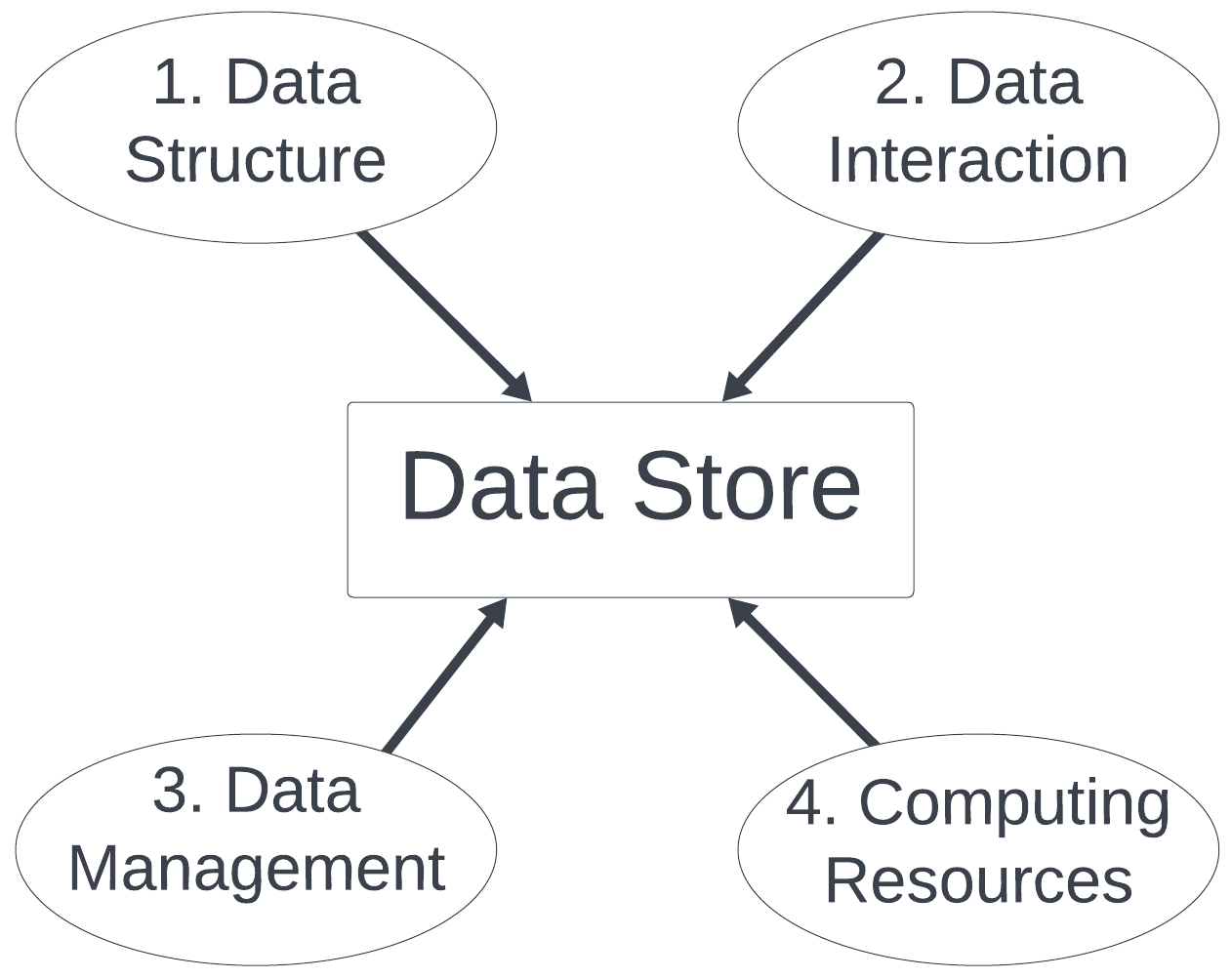2 Data Storage Considerations
When deciding on a method for storing your data (a data store), you have many options. While none of the options will likely be perfect, some are undoubtedly more suited to your situation than others. To figure out which data store will best suit your needs, it is important to consider the following four factors: (1) your data’s structure, (2) the ways you anticipate interacting with your data, (3) your data management needs, and (4) the computing resources you have access to.
Figure 2.1. Diagram outlining four factors to consider when choosing a data
store.

2.1 Data Structure
Your data’s structure describes how your data is organized. While the same information tend to lend them selves to certain data structures. Additionally, different data structures can make it easier or harder to ask specific research questions. Many data stores impose structure on the data they store. To make your life easier, choose a data store whose structure aligns with the types of research questions you want to ask.
2.2 Data Interaction
Generally speaking, collecting data is only an early step on the road to scientific discovery. Once you collect data, that often needs to be cleaned and reformatted before it can be analyzed. Sometimes you have to repeat this process many times, either for different groups of data, or for different types of analysis. In many cases, you may not need all of your data to answer every research question. Some data stores have built in tools to make data manipulation faster, easier, and reproducible. If you spend a lot of time reformatting your data, consider a data store that has this functionality.
2.3 Data Management
Data management concerns the logistics of working with data. It encompasses the challenges of people (including you) interacting with your data over time and space. There are different considerations for data management when you are working on a project alone, as a collaboration, or archiving data for future use. However, similar best practices for data management will benefit them all.
Data Management is a crucial part of valid and reproducible research. Even if you are the only person who will ever interact with your data, you must manage your data in a way that you in the future will be able to recall what past you did, and why. If you collect or modify your data over time, you need to make sure you keep track of those changes, and make sure you are always working with the most up to date version of your data. This could be because you are adding new data or correcting errors in older data. This is doubly important if data gets entered by hand. Some data stores keep track of changes to your data for you and even provide some quality control tools. Others require you to track versions of your data and do quality control manually.
However, science is a collaborative process, so it is more than likely you won’t be the only one working with your data. Any time more than one person needs to access or modify a data set, data management gets more complicated. By default, most computers only allow one person to modify a file at a time, and anyone who has access to that file can edit it. Some data store software has methods for dealing with the conflicts or inconsistencies in data that come from allowing multiple people to modify data so you don’t have to.
Finally, there will come a time when you move on to other projects. If other people still need to use your data, or if your data is part of a public resource you may need to select or change to a data store that is publicly accessible or can be maintained by other members of the project team.
2.4 Computing Resources
Data set size can vary widely. A data set containing information about patients of an early stage drug trial may only contain a few dozen observations. On the other side of the spectrum web scraping social media sites can easily generate terabytes or petabytes of data. Different types of data store software have different limits in terms of how much data they can accommodate. Additionally, some software is free for small data sets, but costs money to use for larger ones. UC Davis provides free or discounted software licenses to researchers. Your lab also may have access to software or data storage specific to your area of study. Finally, if you work with data that contains sensitive information, like medical data, you will need to make sure the data store you select is sufficiently secure.